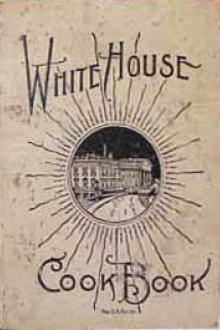The Whitehouse Cookbook (1887), Hugo Ziemann [world of reading .TXT] 📗

- Author: Hugo Ziemann
- Performer: -
Book online «The Whitehouse Cookbook (1887), Hugo Ziemann [world of reading .TXT] 📗». Author Hugo Ziemann
SCOTCH MUTTON BROTH.
Six pounds neck of mutton, three quarts water, five carrots, five turnips, two onions, four tablespoonfuls barley, a little salt. Soak mutton in water for an hour, cut off scrag, and put it in stewpan with three quarts of water. As soon as it boils, skim well, and then simmer for one and one-half hours. Cut best end of mutton into cutlets, dividing it with two bones in each; take off nearly all fat before you put it into broth; skim the moment the meat boils, and every ten minutes afterwards; add carrots, turnips and onions, all cut into two or three pieces, then put them into soup soon enough to be thoroughly done; stir in barley; add salt to taste; let all stew together for three and one-half hours; about one-half hour before sending it to table, put in little chopped parsley and serve.
Cut the meat off the scrag into small pieces, and send it to table in the tureen with the soup. The other half of the mutton should be served on a separate dish, with whole turnips boiled and laid round it. Many persons are fond of mutton that has been boiled in soup.
You may thicken the soup with rice or barley that has first been soaked in cold water, or with green peas, or with young corn, cut down from the cob, or with tomatoes, scalded, peeled and cut into pieces.
GAME SOUP.
Two grouse or partridges, or, if you have neither, use a pair of rabbits; half a pound of lean ham; two medium-sized onions; one pound of lean beef; fried bread; butter for frying; pepper, salt and two stalks of white celery cut into inch lengths; three quarts of water.
Joint your game neatly; cut the ham and onions into small pieces, fry all in butter to a light brown. Put into a soup-pot with the beef, cut into strips, add a little pepper. Pour on the water; heat slowly, and stew gently two hours. Take out the pieces of bird, and cover in a bowl; cook the soup an hour longer; strain; cool; drop in the celery and simmer ten minutes. Pour upon fried bread in the tureen.
Venison soup made the same, with the addition of a tablespoonful of brown flour wet into a paste with cold water, adding a tablespoonful of catsup, Worcestershire, or other pungent sauce, and a glass of Madeira or brown sherry.
CONSOMMÉ SOUP.
Take good strong stock (see pages 27 and 30), remove all fat from the surface, and for each quart of the stock allow the white and shell of one egg and a tablespoonful of water, well whipped together. Pour this mixture into a saucepan containing the stock; place it over the fire and heat the contents gradually, stirring often to prevent the egg from sticking to the bottom of the saucepan. Allow it to boil gently until the stock looks perfectly clear under the egg, which will rise and float upon the surface in the form of a thick white scum. Now remove it and pour it into a folded towel laid in a colander set over an earthen bowl, allowing it to run through without moving or squeezing it. Season with more salt if needed, and quickly serve very hot. This should be a clear amber color.
JULIENNE SOUP.
Cut carrots and turnips into quarter-inch pieces the shape of dice; also celery into thin slices. Cover them with boiling water; add a teaspoonful of salt, half a teaspoonful pepper, and cook until soft. In another saucepan have two quarts of boiling stock (see pages 27 and 30), to which add the cooked vegetables, the water and more seasoning if necessary. Serve hot.
In the spring and summer season use asparagus, peas and string beans—all cut into small uniform thickness.
CREAM OF SPINACH.
Pick, wash and boil enough spinach to measure a pint, when cooked, chopped and pounded into a soft paste. Put it into a stewpan with four ounces of fresh butter, a little grated nutmeg, a teaspoonful of salt. Cook and stir it about ten minutes. Add to this two quarts of strong stock (see pages 27 and 30); let boil up, then rub it through a strainer. Set it over the fire again, and, when on the point of boiling, mix with it a tablespoonful of butter, and a teaspoonful of granulated sugar.
CHICKEN CREAM SOUP.
An old chicken for soup is much the best. Cut it up into quarters, put it into a soup kettle with half a pound of corned ham, and an onion; add four quarts of cold water. Bring slowly to a gentle boil, and keep this up until the liquid has diminished one-third, and the meat drops from the bones; then add half a cup of rice. Season with salt, pepper and a bunch of chopped parsley.
Cook slowly until the rice is tender, then the meat should be taken out. Now stir in two cups of rich milk thickened with a little flour. The chicken could be fried in a spoonful of butter and a gravy made, reserving some of the white part of the meat, chopping it and adding it to the soup.
PLAIN ECONOMICAL SOUP.
Take a cold roast-beef bone, pieces of beefsteak, the rack of a cold turkey or chicken. Put them into a pot with three or four quarts of water, two carrots, three turnips, one onion, a few cloves, pepper and salt. Boil the whole gently four hours; then strain it through a colander, mashing the vegetables so that they will all pass through. Skim off the fat, and return the soup to the pot. Mix one tablespoonful of flour with two of water, stir it into the soup and boil the whole ten minutes. Serve this soup with sippits of toast.
Sippits are bits of dry toast cut into a triangular form.
A seasonable dish about the holidays.
OX-TAIL SOUP.
Two ox-tails, two slices of ham, one ounce of butter, two carrots, two turnips, three onions, one leek, one head of celery, one bunch of savory herbs, pepper, a tablespoonful of salt, two tablespoonfuls of catsup, one-half glass of port wine, three quarts of water.
Cut up the tails, separating them at the joints; wash them, and put them in a stewpan with the butter. Cut the vegetables in slices and add them with the herbs. Put in one-half pint of water, and stir it over a quick fire till the juices are drawn. Fill up the stewpan with water, and, when boiling, add the salt. Skim well, and simmer very gently for four hours, or until the tails are tender. Take them out, skim and strain the soup, thicken with flour, and flavor with the catsup and port wine. Put back the tails, simmer for five minutes and serve.
Another way to make an appetizing ox-tail soup. You should begin to make it the day before you wish to eat the soup. Take two tails, wash clean, and put in a kettle with nearly a gallon of cold water; add a small handful of salt; when the meat is well cooked, take out the bones. Let this stand in a cool room, covered, and next day, about an hour and a half before dinner, skim off the crust or cake of fat which has risen to the top. Add a little onion, carrot, or any vegetables you choose, chopping them fine first; summer savory may also be added.
CORN SOUP.
Cut the corn from the cob, and boil the cobs in water for at least an hour, then add the grains, and boil until they are thoroughly done; put one dozen ears of corn to a gallon of water, which will be reduced to three quarts by the time the soup is done; then pour on a pint of new milk, two well-beaten eggs, salt and pepper to your taste; continue the boiling a while longer, and stir in, to season and thicken it a little, a tablespoonful of good butter rubbed up with two tablespoonfuls of flour. Corn soup may also be made nicely with water in which a pair of grown fowls have been boiled or parboiled, instead of having plain water for the foundation.
SPLIT PEA SOUP. No. 1.
Wash well a pint of split peas and cover them well with cold water, adding a third of a teaspoonful of soda; let them remain in it over night to swell. In the morning put them in a kettle with a close fitting cover. Pour over them three quarts of cold water, adding half a pound of lean ham or bacon cut into slices or pieces; also a teaspoonful of salt and a little pepper, and some celery chopped fine. When the soup begins to boil, skim the froth from the surface. Cook slowly from three to four hours, stirring occasionally till the peas are all dissolved, adding a little more boiling water to keep up the quantity as it boils away. Strain through a colander, and leave out the meat. It should be quite quick. Serve with small squares of toasted bread, cut up and added. If not rich enough, add a small piece of butter.
CREAM OF ASPARAGUS.
For making two quarts of soup, use two bundles of fresh asparagus. Cut the tops from one of the bunches and cook them twenty minutes in salted water, enough to cover them. Cook the remainder of the asparagus about twenty minutes in a quart of stock or water. Cut an onion into thin slices and fry in three tablespoonfuls of butter ten minutes, being careful not to scorch it; then add the asparagus that has been boiled in the stock; cook this five minutes, stirring constantly; then add three tablespoonfuls of dissolved flour, cook five minutes longer. Turn this mixture into the boiling stock and boil twenty minutes. Rub through a sieve; add the milk and cream and the asparagus heads. If water is used in place of stock, use all cream.
GREEN PEA SOUP.
Wash a small quarter of lamb in cold water, and put it into a soup-pot with six quarts of cold water; add to it two tablespoonfuls of salt, and set it over a moderate fire—let it boil gently for two hours, then skim it clear; add a quart of shelled peas, and a teaspoonful of pepper; cover it, and let it boil for half an hour; then having scraped the skins from a quart of small young potatoes, add them to the soup; cover the pot and let it boil for half an hour longer; work quarter of a pound of butter and a dessertspoonful of flour together, and add them to the soup ten or twelve minutes before taking it off the fire.
Serve the meat on a dish with parsley sauce over it, and the soup in a tureen.
DRIED BEAN SOUP.
Put two quarts of dried white beans to soak the night before you make the soup, which should be put on as early in the day as possible.
Take two pounds of the lean of fresh beef—the coarse pieces will do. Cut them up and put them into your soup-pot with the bones belonging to them (which should be broken in pieces), and a pound of lean bacon, cut very small. If you have the remains of a piece of beef that has been roasted the day before, and so much underdone that the juices remain in it, you may put it into the pot and its bones along with it.





Comments (0)